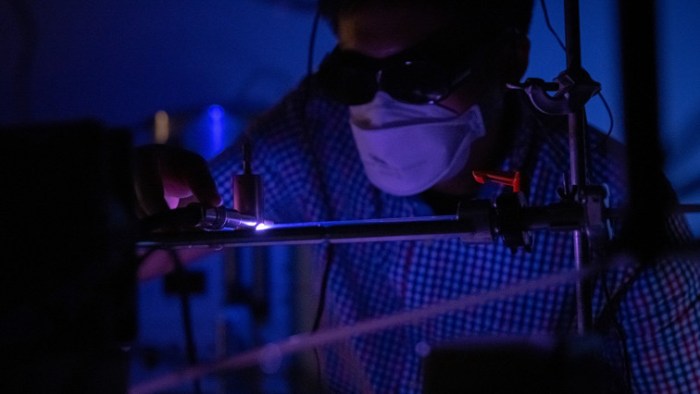Samsung’s Graphene Breakthrough
Samsung’s recent breakthrough in graphene technology has sent ripples through the tech world, promising a future where flexible electronics are not just a futuristic concept but a tangible reality. This advancement is poised to revolutionize how we interact with technology, with implications that extend far beyond smartphones and tablets.
Addressing Limitations of Flexible Electronics
The development of flexible electronics has been hampered by several key limitations. One of the biggest hurdles has been the lack of materials that can withstand the bending and flexing required for these devices while maintaining their electrical conductivity. Traditional materials like silicon, while robust, are brittle and prone to cracking under stress, making them unsuitable for flexible applications. Samsung’s graphene technology addresses this issue head-on.
Graphene, a single layer of carbon atoms arranged in a honeycomb lattice, is known for its exceptional strength, flexibility, and conductivity. It is significantly stronger than steel, yet incredibly thin and flexible, making it ideal for use in bendable and foldable devices.
Samsung’s breakthrough lies in its ability to produce large-scale, high-quality graphene sheets that can be seamlessly integrated into electronic devices. This breakthrough overcomes the previous limitations of graphene production, which was often limited to small, lab-scale quantities, hindering its widespread adoption.
Potential Applications of Samsung’s Graphene Technology
Samsung’s graphene technology holds immense potential for a wide range of applications, transforming various industries:
- Flexible Displays: Graphene’s flexibility and transparency make it an ideal material for next-generation displays. Imagine smartphones that can be folded, rolled, or even worn like a piece of clothing.
- Wearable Electronics: Graphene’s lightweight and flexible nature opens up possibilities for truly wearable devices. Imagine sensors woven into clothing that can monitor your health, fitness, and even environmental conditions.
- Energy Storage: Graphene’s high surface area and conductivity make it a promising material for high-performance batteries. This could lead to lighter, longer-lasting batteries for everything from smartphones and electric vehicles to medical implants.
- Sensors and Actuators: Graphene’s sensitivity to changes in its environment makes it ideal for use in advanced sensors. This could lead to the development of ultra-sensitive sensors for medical diagnostics, environmental monitoring, and even security applications.
The Future of Flexible Electronics
Samsung’s graphene breakthrough has the potential to revolutionize the field of flexible electronics, opening up a world of possibilities for devices that can bend, fold, and even stretch. This breakthrough could lead to a future where our gadgets are no longer confined to rigid, rectangular forms, but instead adapt to our needs and environments.
Potential Benefits of Flexible Electronics
The potential benefits of flexible electronics are vast and far-reaching. Here are some key areas where this technology could make a significant impact:
- Wearable Devices: Flexible electronics could enable the creation of more comfortable and functional wearable devices. Imagine smartwatches that wrap seamlessly around your wrist, or clothing that monitors your health and fitness.
- Foldable Displays: Flexible screens could pave the way for foldable smartphones, tablets, and even laptops that can be easily folded and carried in your pocket. These devices could offer a larger screen experience while still being compact and portable.
- Emerging Technologies: Flexible electronics could also play a crucial role in the development of other emerging technologies, such as electronic skin, flexible solar cells, and even artificial muscles.
Challenges to Widespread Adoption
While the potential of flexible electronics is undeniable, there are still several challenges that need to be addressed before they become mainstream:
- Cost: The production of flexible electronics is currently expensive, making them less accessible to the average consumer.
- Durability: Flexible devices need to be durable enough to withstand the rigors of everyday use, especially in harsh environments.
- Integration: Integrating flexible electronics into existing systems and devices can be challenging, requiring new design approaches and manufacturing techniques.
Samsung’s Competitive Advantage: Samsung Graphene Breakthrough Makes Flexible Electronics Future Look Bright
Samsung’s graphene breakthrough positions the company as a frontrunner in the burgeoning flexible electronics market. This innovation could potentially revolutionize the way we interact with technology, paving the way for a future where devices are bendable, foldable, and even rollable.
Comparison with Existing Technologies
Samsung’s graphene technology presents a compelling advantage over existing technologies in flexible electronics. While other materials like indium tin oxide (ITO) have been used for flexible displays, they suffer from limitations such as brittleness and high production costs. Graphene, on the other hand, offers superior conductivity, flexibility, and transparency, making it a highly promising material for next-generation displays and other flexible electronic components.
Potential Competitors and Their Strengths and Weaknesses, Samsung graphene breakthrough makes flexible electronics future look bright
The flexible electronics market is becoming increasingly competitive, with several companies vying for dominance. Some key competitors include:
- LG Electronics: LG has been a strong player in the flexible display market, particularly with its OLED technology. However, LG’s focus on OLED displays might limit its ability to fully capitalize on the broader flexible electronics market.
- Apple: Apple has shown interest in flexible electronics with its rumored foldable iPhone. However, Apple’s reliance on external suppliers for key components could potentially hinder its ability to fully control the flexible electronics value chain.
- Huawei: Huawei has been actively investing in flexible display technology and has even launched its own foldable smartphones. However, Huawei’s current focus on the Chinese market might limit its global reach in the flexible electronics sector.
While these companies pose significant competition, Samsung’s early investment in graphene technology and its strong vertical integration in the electronics supply chain provide a distinct advantage. Samsung’s ability to control the entire process from materials development to device manufacturing allows it to optimize production costs and ensure the quality of its products.
“Samsung’s graphene breakthrough is a game-changer for the flexible electronics industry. It has the potential to reshape the future of technology and position Samsung as a leader in this exciting new market.” – Industry Analyst
Impact on the Technology Industry
Samsung’s graphene breakthrough is not just a technological marvel; it’s a seismic shift in the technology industry. This breakthrough could reshape the future of electronics, paving the way for devices that are lighter, more flexible, and more durable than ever before.
Implications for Research and Development
This breakthrough has the potential to ignite a new wave of research and development in the field of materials science and electronics. Researchers will now have access to a new material with incredible properties, opening up a vast landscape of possibilities for innovation. This could lead to the development of entirely new types of electronics, including:
- Flexible displays: Imagine smartphones that fold like paper, or TVs that can be rolled up and stored away. Graphene’s flexibility and durability make it ideal for creating these next-generation displays.
- Wearable electronics: Graphene’s lightweight and flexible nature makes it perfect for wearable devices, such as smartwatches, fitness trackers, and even clothing that can monitor your health.
- High-performance computing: Graphene’s excellent conductivity and thermal properties make it a promising material for developing faster and more efficient computer chips.
The potential applications of graphene are vast and exciting, pushing the boundaries of what we consider possible in electronics.
Samsung graphene breakthrough makes flexible electronics future look bright – Samsung’s graphene breakthrough is more than just a technological marvel; it’s a glimpse into a future where electronics seamlessly blend with our lives. This innovation promises to transform industries, from consumer electronics to healthcare, opening up a world of possibilities that were once confined to science fiction. As Samsung continues to push the boundaries of what’s possible, we can expect to see even more incredible advancements in flexible electronics, making the future even brighter than we imagined.
Samsung’s graphene breakthrough paints a rosy picture for the future of flexible electronics, but it seems the tech world is already facing a supply crunch. Apple Watch shipping estimates are hinting at a potential supply constraint, which might be a sign of things to come as demand for flexible devices ramps up. Perhaps the future of tech isn’t just about bendy screens, but also about navigating the complexities of manufacturing them at scale.
 Standi Techno News
Standi Techno News

